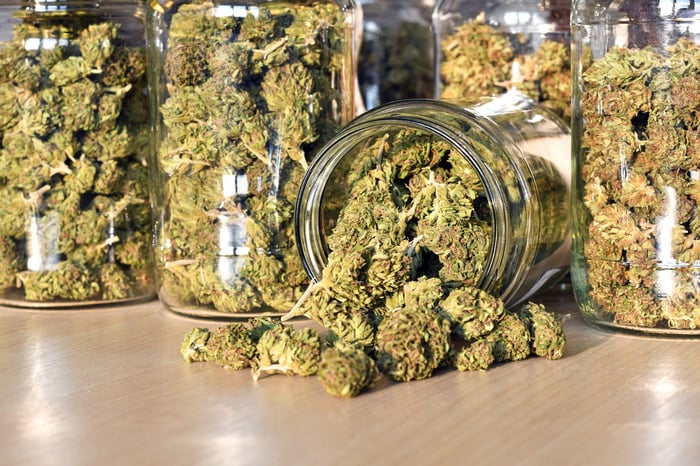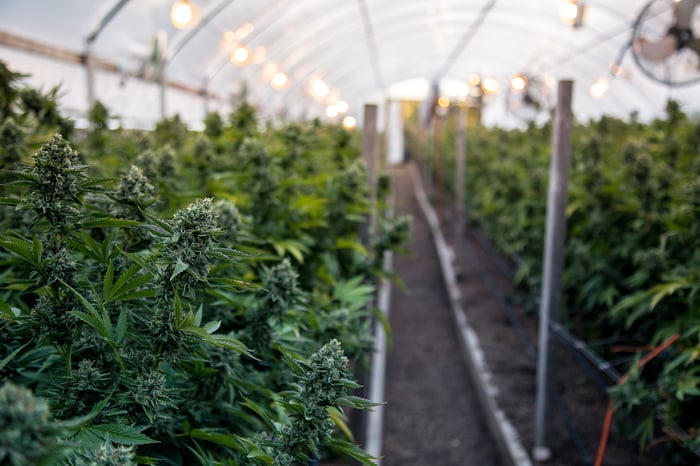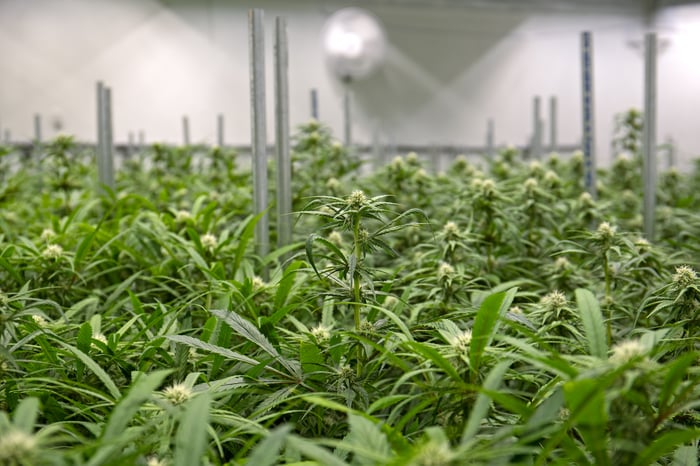The legal weed industry is now less than a week away from a monumental vote in Canada. The country's Senate is slated to vote on bill C-45 (officially the Cannabis Act) on June 7, with passage of the bill seen as likely. Soon thereafter, adult-use marijuana could become legal throughout the country, making Canada the first developed country in the world to allow adults to purchase cannabis legally.
Legalizing recreational marijuana should add an estimated $5 billion or more in annual revenue to Canada's already rapidly growing pot industry. It also means an escalating battle of capacity expansion, with all growers wanting to deliver as much production as possible when the proverbial green flag waves, in order for them to secure lucrative long-term supply deals.

Image source: Getty Images.
In total, eight Canadian cannabis growers are currently on track to produce in excess of 100,000 kilograms at full capacity. Though it takes a bit of guesswork, since not all these growers have been up front about their production capacity, the following eight growers look to be industry leaders.
1. Canopy Growth Corp.: 500,000 kg
Canopy Growth Corp. (CGC 0.09%) is the largest marijuana stock in the world by market cap, and it recently became the first weed stock to list on the New York Stock Exchange. At the moment, Canopy has 2.4 million square feet of licensed grow space in British Columbia, a tripling from where it began the year. And it expects to increase its licensed grow space to 5.7 million square feet over time. Though Canopy Growth hasn't exactly been forthcoming with an annual production estimate, a figure of around 500,000 kilograms seems doable at full capacity.
2. Aurora Cannabis: 430,000 kg
Technically, Aurora Cannabis (ACB -5.41%) could soon be even larger than Canopy Growth, given its proposed acquisition of MedReleaf (NASDAQOTH: MEDFF). But until that deal closes, Aurora's fully funded annual capacity sits around 430,000 kilograms. This is based on its 800,000-square-foot Aurora Sky facility; the 1-million-square-foot Aurora Nordic facility in Denmark that's a partnership with Alfred Pedersen & Son; and the newly announced 1.2-million-square-foot Aurora Sun facility, which is to be built in Medicine Hat, Alberta.

Image source: Getty Images.
3. Aphria: 230,000 kg
Next up is Aphria (NASDAQOTH: APHQF), which is expected to produce about 230,000 kilograms a year at full capacity. The company has two core projects: Aphria One, its organic four-phase, 1-million-square-foot build-out that's expected to be completed in January 2019; and Aphria Diamond, a partnership with Double Diamond Farms that's expected to be complete around the same time.
4. MedReleaf: 140,000 kg
As noted, MedReleaf is in the process of being acquired by Aurora Cannabis in an all-share deal for about $2.5 billion (when announced). MedReleaf's Markham and Bradford facilities should combine for about 35,000 kilograms in peak capacity, but it's the recently acquired Exeter facility that'll do most of the heavy lifting. Once retrofitted, this roughly 1-million-square-foot facility will be capable of 105,000 kilograms of annual production.
5. The Green Organic Dutchman: 116,000 kg
Having recently gone public in the largest weed IPO in history, The Green Organic Dutchman (TGOD.F -26.49%) stands capable of producing 116,000 kilograms of cannabis per year. This production will come from two sites. Its Quebec Project spans 75 acres near Montreal, and covers 820,000 square feet. It should produce approximately 102,000 kilograms at full capacity. Second is the Ontario Project, which will expand the company's existing Ontario facility to 150,000 square feet, ultimately adding 14,000 kilograms of production per year.

Image source: Getty Images.
6. OrganiGram Holdings: 113,000 kg
Another grower expected to generate in excess of 100,000 kilograms a year is New Brunswick-based OrganiGram Holdings (OGI -1.33%). Unlike its peers that have multiple grow sites, OrganiGram has decided to centralize its expansion in one location: its Moncton facility. Having consistently generated crop yields that were above expectation, OrganiGram earlier this year upped its fully funded annual production forecast to 113,000 kilograms from a previous forecast of 65,000 kilograms. Construction is expected to be complete by April 2020.
7. Hydropothecary: 108,000 kg
Hydropothecary (HEXO) really made a name for itself in April when it secured a five-year supply deal from Quebec that worked out to about 200,000 kilograms. Already working with its 65-acre Gatineau, Quebec, facility, in December the company announced the purchase of 78 acres adjacent to this facility. A newly constructed 1-million-square-foot facility on this property is going to allow Hydropothecary to produce 108,000 kilograms a year over approximately 1.3 million square feet of growing space.
8. Emerald Health Therapeutics: Over 100,000 kg
Lastly, there's Emerald Health Therapeutics, which is retrofitting a tomato-producing greenhouse owned by Village Farms International under the Pure Sunfarms joint venture. When this 1.1-million-square-foot facility is operating at full capacity in 2020, it'll be capable of 75,000 kilograms of peak annual production. Meanwhile, Emerald Health has its own Vancouver-based project that it's constructing, which will contain its headquarters. Combined, these two projects should allow Emerald Health Therapeutics to surpass 100,000 kilograms of annual cannabis production.
Keep in mind that because of partnerships, newly announced projects, and acquisitions, production totals have been exceptionally fluid in recent months, and are likely to change again. However, for the time being at least, these are the key players in Canada's burgeoning marijuana industry.





